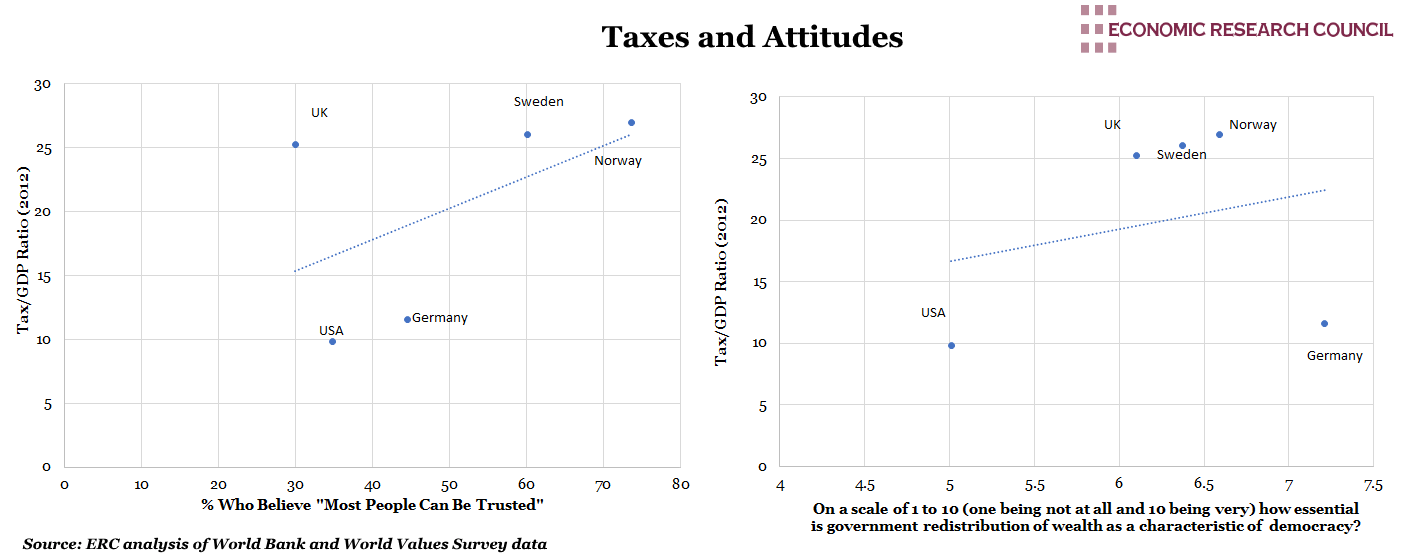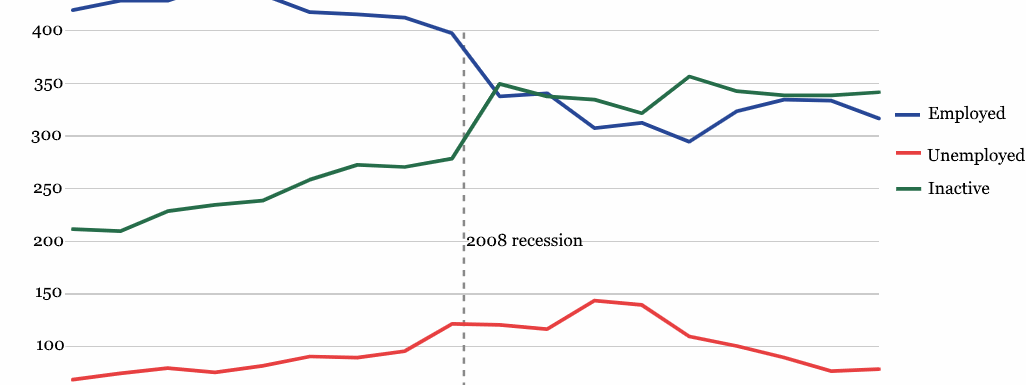
Summary
There is a passive belief or narrative that tax rates and government programs depend upon cultural and social norms. The data presented in these charts, guided by How Can Scandinavians Tax So Much? (Kleven 2014) goes some way to add substance to this discussion. As stated in this paper, while it is easier to display causation between cultural norms of trust and fairness and tax compliance, it is harder to claim that these beliefs lead to higher tax rates overall. The charts above lend credence to this and provoke interesting discussion on the topic.
What does the chart show?
The first chart plots the relationship between the percentage of a nation’s citizens who agree with the statement that “Most People Can Be Trusted” (on the x-axis) and the amount of taxes paid in that nation as a percent of GDP (on the y-axis). The survey data was extracted from the World Values Survey (WVS) which is conducted using a representative sample of at least 1000 individuals within each nation. The dots representing each country in this chart display a clear positive association between interpersonal trust and taxes. The second chart plots the relationship between the belief that government redistribution of wealth is an essential characteristic of democracy (on the x-axis) and the amount of taxes paid in that nation as percent of GDP (on the y-axis). The World Values Survey asked respondents to state on a scale of 1 to 10 (1 being not at all and 10 being very) how essential government redistribution of wealth is as a characteristic of a democracy. The mean response value for the sample from each respective nation represented is plotted on the x-axis. Again, there is a positive association between these two variables.
Why is the chart interesting?
There has been an abundance of recent and interesting literature on the concept of ‘Tax Morale’. Most have focused on the prevalence of tax evasion. Instead, Kleven researches around the level of government revenue and the tax rates required in various nations. ‘Tax Morale’ is described as willingness to pay taxes but can be differentiated further into categories. The literature which discusses tax evasion focuses more on the willingness to pay the taxes already required by law. In a different manner, the studies that discuss gross government revenue and tax rates focus on the willingness to pay more or higher taxes.
The first chart shows a clear positive association between societal trust and tax rates. While the relationship is strong, it may not imply causation. Similar to a concern raised by Glaeser et al. (2000), the WVS data may not predict the trust that citizens have for one another but rather the incidence of trustworthy behaviour. Although where citizens display a larger level of trust for one another this could plausibly lead to larger government programs and higher taxes; the perception of the commonality of trustworthy behavior is less likely to cause a similar effect. Alm and Torgler (2006) provide the data that demonstrates why this is the case. As represented in their analysis, the United States had the highest tax morale among OECD nations. The people of the United States were comparatively more willing to pay taxes and less likely to avoid taxes. This would imply a high rate of trustworthy behavior, but not a high overall tax rate. Further, a reverse causality could be reflected in the data. Fewer cases of tax evasion and a higher presence and scale of public institutions in society could instead be causing citizens to have higher levels of trust in one another.
While the association between the two variables in the second chart is not as strong as in the first, the similar positions of the nations represented across the two graphs is still noteworthy. The fact that citizens would be willing to pay a higher proportion of their income in taxes does logically follow from a more prevalent belief in redistributive programs as essential for democratic societies. This question as articulated by the WVS does more broadly relate to societal beliefs about poverty and its relation to laziness and will power. Nations which have a higher prevalence of the belief that poverty is caused by laziness have lower tax rates. The opposite is true for nations which believe that the poor are ‘unlucky’ or are not treated fairly by society. While this relationship does not have as many potential issues with framing or causation, the weaker association between the data points means that this measure alone is not conclusive as a determinant of higher vs. lower tax rates.
While this is the case, a certain structure of cultural norms and social beliefs does correspond strongly with such government policies. As mentioned by Kleven, participation in society, crime, tax evasion, and general ‘social cohesiveness’ can reveal much about social preferences when it comes to tax rates and government programs such as wealth redistribution.
Week 17, 2019

